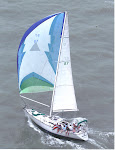Entrance to northern creek in Shroud Cay
Shallow Part near the Entrance
Interior of Shroud Cay is all sand and mangroves
Creek opens out in Exuma Sound
Ocean beach adjacent to the creek
Picture does not do justice to drama of frontal clouds
Friends Daniel and Lucy seen on Allen's Cay
Shroud Cay, a part of the
Exuma Land and Sea Park of the Bahamas, is a magical place. It is
not inhabited and is preserved as a nature reserve. Most of the
interior is tidal mangrove swamps interlaced with shallow creeks.
One of these creeks, the northern most one, transects the cay from
banks to ocean (actually Exuma Sound). It does not have a name that I
know of.
White Pepper
with buddy boat Gizmo I
took on the challenge of crossing the cay at low tide. We had to
“portage” the dingy for a bit, but the creek became deeper in the
interior. Reference to the “African Queen” were inevitable
although only short mangrove lined the creek, not jungle. There was
abundant fish in the creek as they are under the protection of the
Park.
With
persistence and grit we did eventually gain the opening of the creek
to the ocean. We were rewarded with possibly the most spectacular
scene in the entire park. I was certainly impressed as the jungle
scene gave way to an expansive white beach of the softest sand
imaginable. The isolation and solitude was like something out of the
Creation. After exploring the beach we climbed the dunes and were
rewarded with a remarkable panorama of the island's interior. Mostly
dry at low tide, it was rapidly filling up on the flood. I missed the picture because the camera's battery died. On this day
the drama was increased beyond the usual by the passing of a weak
cold front while we were on the beach. Dramatic clouds roiled
overhead. The temperature dropped 10 degrees. An absolutely still
emerald green sea began to ruffle in the new wind. The creek went
from a gentle meander to a rushing stream as the tide rose and pushed
water in from the sea.
The
trip up the creek took at least 45 minutes motoring most of the way.
The trip downstream was a sleigh ride of 10 minutes. We were spit
out out onto the shallow banks (2 foot maximum depth) surrounding the
cay. On the trip back to the boats I thought that this was one of
those “bucket list” moments even though none of us had been
prepared in advance for the experience. The northern creek on Should
Cay is truly one of natures wonders.





















